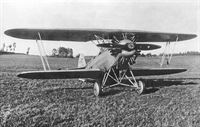Фотографии
-
Регистрационный номер: D-1212 Gerhard Fieseler beside Raab-Katzenstein Kl.1c Schwalbe D-1212 during the 1928 German aerobatic championships.
Самолёты на фотографии: Raab-Katzenstein RK.1 Schwalbe / RK.2 Pelikan / RK.9 Grasmucke - Германия - 1926
-
Регистрационный номер: SE-ADK The original RK-26 SE-ACO was re-registered as SE-ADK in 1932, before being sold in 1934 to the first of a number of new owners, including the Norrkoping Automobile Flying Club and Lennart Hemminger, who donated the aircraft for use by F 19, Sweden’s volunteer unit in Finland, in early 1940.
Самолёты на фотографии: Raab-Katzenstein RK.26 Tigerschwalbe - Германия - 1929
-
One of the first production Sk 10s was photographed on January 25, 1934, probably just before its delivery to Flygvapnet. The Walter Castor IA seven-cylinder radial engine was of Czechoslovakian origin, the Walter company being a specialist in small three-, five-, seven- and nine-cylinder radials throughout the 1920s.
Самолёты на фотографии: Raab-Katzenstein RK.26 Tigerschwalbe - Германия - 1929
-
An Sk 10 taxies in after a solo training flight. An attractive, well-proportioned biplane, the type nevertheless required a much higher level of skill to fly than other contemporary trainers, particularly the de Havilland Moth, which some Flygvapnet officers felt was a more suitable training machine.
Самолёты на фотографии: Raab-Katzenstein RK.26 Tigerschwalbe - Германия - 1929
-
The cockpit of Sk 10 c/n 19, serial 535, wearing the number of its unit, F 5, ahead of the national tri-crown marking, and individual code number “41” aft of it, as per standard in 1936. The controls were duplicated front and rear, and the type was intended to provide the requisite skills to convert to Flygvapnet’s Bristol Bulldogs.
Самолёты на фотографии: Raab-Katzenstein RK.26 Tigerschwalbe - Германия - 1929
-
A report on the “Tiger-Swallow” in the June 1933 issue of American magazine Popular Flying explained that “the great strength of the machine is due to the use of tubes and sheets of Swedish nickel-chrome steel. This steel has a tensile strength almost triple that of the tubing and sheet used in most aircraft”. But it was also heavier.
Самолёты на фотографии: Raab-Katzenstein RK.26 Tigerschwalbe - Германия - 1929
-
German aerobatic champion Gerhard Fieseler with one of the Raab-Katzenstein biplanes he helped to design in the late 1920s. Fieseler would go on to win a German design competition for a STOL liaison aircraft in 1936 with his famous Storch.
Самолёты на фотографии: Raab-Katzenstein RK.26 Tigerschwalbe - Германия - 1929
-
Регистрационный номер: SE-ACO A rare head-on view of the first RK-26 to be imported into Sweden, SE-ACO, which was fitted with a 200 h.p. Armstrong Siddeley Lynx, replaced on production Sk 10s with the heavier Walter Castor IA.
Самолёты на фотографии: Raab-Katzenstein RK.26 Tigerschwalbe - Германия - 1929
-
Retaining the Tigerschwalbe’s purposeful lines, the Sk 10 was nevertheless an entirely different animal, being considerably heavier - with a consequently higher wing loading - than its forerunner. In total, 25 examples were built, nearly three-quarters of which had been written off by the time the last example was retired in 1945.
Самолёты на фотографии: Raab-Katzenstein RK.26 Tigerschwalbe - Германия - 1929
-
A line-up of Sk 10s at Rinkaby airfield in southern Sweden in September 1936, by which time five of the 25 had been written off in accidents, although all of the mishaps that befell the type were ascribed to pilot error, rather than an inherent design flaw in the aircraft. Despite the high attrition rate, only two people were killed in Sk 10s.
Самолёты на фотографии: Raab-Katzenstein RK.26 Tigerschwalbe - Германия - 1929
-
The original RK-26 SE-ACO was re-registered as SE-ADK in 1932, before being sold in 1934 to the first of a number of new owners, including the Norrkoping Automobile Flying Club and Lennart Hemminger, who donated the aircraft for use by F 19, Sweden’s volunteer unit in Finland, in early 1940.
Самолёты на фотографии: Raab-Katzenstein RK.26 Tigerschwalbe - Германия - 1929
Статьи
- -
- A.Tincopa - Wings over Peru
- B.Turpin - Out on a Lympne (1)
- C.Gibson - Swing-wing London?
- D.Green - Biggin or Bust!
- J.Forsgren - The Imperfect 10
- J.Franzi - An Eye on the Prize /An eye for detail/
- J.Stroud - To Belfast by Jupiter! /The John Stroud Archive/
- M.Parry - Major Horace Buss
- N.Stroud - Viva Las Vegas!
- P.Davidson - Off the Beaten Track...
- P.Fiddian - The Stefan Karwowski Factor
- P.Jarrett - Lost & Found
- P.Vabre - Paper Trails in the Sky
- R.Forsyth - Defending the Reich (1)
- T.Cooper - Baptism of War










